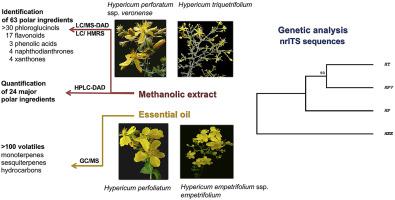当前位置:
X-MOL 学术
›
Phytochemistry
›
论文详情
Our official English website, www.x-mol.net, welcomes your
feedback! (Note: you will need to create a separate account there.)
Metabolomic fingerprinting and genetic discrimination of four Hypericum taxa from Greece
Phytochemistry ( IF 3.2 ) Pub Date : 2020-06-01 , DOI: 10.1016/j.phytochem.2020.112290 Konstantina Zeliou 1 , Eirini-Maria Koui 1 , Charikleia Papaioannou 2 , Nikolaos Stavros Koulakiotis 3 , Gregoris Iatrou 4 , Anthony Tsarbopoulos 5 , Vassilis Papasotiropoulos 6 , Fotini N Lamari 1
Phytochemistry ( IF 3.2 ) Pub Date : 2020-06-01 , DOI: 10.1016/j.phytochem.2020.112290 Konstantina Zeliou 1 , Eirini-Maria Koui 1 , Charikleia Papaioannou 2 , Nikolaos Stavros Koulakiotis 3 , Gregoris Iatrou 4 , Anthony Tsarbopoulos 5 , Vassilis Papasotiropoulos 6 , Fotini N Lamari 1
Affiliation

|
Hypericum perforatum has plenty of uses in traditional medicine and is the source of top-selling herbal drugs and food supplements. The secondary metabolite chemistry for most of the nearly 500 Hypericum taxa is still unknown, even though they are used interchangeably. In the present study, we characterized four Hypericum populations from Achaia, Greece, belonging to H. perforatum ssp. veronense, H. perfoliatum, H. triquetrifolium, and an uninvestigated taxon, H. empetrifolium ssp. empetrifolium, in terms of their essential oils and polar bioactives in methanolic extracts via GC-MS, LC-HRMS, LC-DAD-MS, and HPLC-DAD. We also performed sequence analysis of nrITS to explore the genetic profile of these taxa and to examine whether their genotype is correlated to the metabolome. Sixty-three non-volatile compounds, phloroglucinols in their majority, and over one hundred (113) volatiles, mostly sesqui- and mono- terpenes, were detected. The concentration of the major polar constituents varied greatly among samples. In particular, phloroglucinols' diversity and abundance in H. empetrifolium ssp. empetrifolium was remarkable. The PCA and Biplot analysis revealed the contribution of each compound to the total chemodiversity and also revealed certain compounds that contribute to the discrimination of the samples. Sequence analysis of nrITS revealed different genetic profiles and markers which can be used for the identification of the four Hypericum taxa. The Mantel test showed a relatively strong correlation between the genetic profile and the volatile compounds and low with the main polar metabolites.
中文翻译:

希腊四种金丝桃属植物的代谢组学指纹图谱及遗传鉴别
贯叶连翘在传统医学中有很多用途,是最畅销的草药和食品补充剂的来源。近 500 个金丝桃类群中的大多数的次生代谢物化学仍然未知,即使它们可以互换使用。在本研究中,我们描述了来自希腊亚该亚的四个金丝桃种群,属于 H. perforatum ssp。veronense、H. perfoliatum、H. triquetrifolium 和一个未经调查的分类群 H. empetrifolium ssp。empetrifolium,通过 GC-MS、LC-HRMS、LC-DAD-MS 和 HPLC-DAD 测定甲醇提取物中的精油和极性生物活性物质。我们还对 nrITS 进行了序列分析,以探索这些分类群的遗传谱,并检查它们的基因型是否与代谢组相关。六十三种非挥发性化合物,间苯三酚占大多数,并且检测到超过一百 (113) 种挥发物,主要是倍半萜和单萜。主要极性成分的浓度在样品之间差异很大。特别是,间苯三酚在 H. empetrifolium ssp 中的多样性和丰度。empetrifolium 是显着的。PCA 和 Biplot 分析揭示了每种化合物对总化学多样性的贡献,还揭示了有助于区分样品的某些化合物。nrITS 的序列分析揭示了不同的遗传谱和标记,可用于鉴定四种金丝桃类群。Mantel 测试显示遗传特征与挥发性化合物之间的相关性相对较强,而与主要极性代谢物的相关性较低。主要极性成分的浓度在样品之间差异很大。特别是,间苯三酚在 H. empetrifolium ssp 中的多样性和丰度。empetrifolium 是显着的。PCA 和 Biplot 分析揭示了每种化合物对总化学多样性的贡献,还揭示了有助于区分样品的某些化合物。nrITS 的序列分析揭示了不同的遗传谱和标记,可用于鉴定四种金丝桃类群。Mantel 测试显示遗传特征与挥发性化合物之间的相关性相对较强,而与主要极性代谢物的相关性较低。主要极性成分的浓度在样品之间差异很大。特别是,间苯三酚在 H. empetrifolium ssp 中的多样性和丰度。empetrifolium 是显着的。PCA 和 Biplot 分析揭示了每种化合物对总化学多样性的贡献,还揭示了有助于区分样品的某些化合物。nrITS 的序列分析揭示了不同的遗传谱和标记,可用于鉴定四种金丝桃类群。Mantel 测试显示遗传特征与挥发性化合物之间的相关性相对较强,而与主要极性代谢物的相关性较低。empetrifolium 是显着的。PCA 和 Biplot 分析揭示了每种化合物对总化学多样性的贡献,还揭示了有助于区分样品的某些化合物。nrITS 的序列分析揭示了不同的遗传谱和标记,可用于鉴定四种金丝桃类群。Mantel 测试显示遗传特征与挥发性化合物之间的相关性相对较强,而与主要极性代谢物的相关性较低。empetrifolium 是显着的。PCA 和 Biplot 分析揭示了每种化合物对总化学多样性的贡献,还揭示了有助于区分样品的某些化合物。nrITS 的序列分析揭示了不同的遗传谱和标记,可用于鉴定四种金丝桃类群。Mantel 测试显示遗传特征与挥发性化合物之间的相关性相对较强,而与主要极性代谢物的相关性较低。
更新日期:2020-06-01
中文翻译:

希腊四种金丝桃属植物的代谢组学指纹图谱及遗传鉴别
贯叶连翘在传统医学中有很多用途,是最畅销的草药和食品补充剂的来源。近 500 个金丝桃类群中的大多数的次生代谢物化学仍然未知,即使它们可以互换使用。在本研究中,我们描述了来自希腊亚该亚的四个金丝桃种群,属于 H. perforatum ssp。veronense、H. perfoliatum、H. triquetrifolium 和一个未经调查的分类群 H. empetrifolium ssp。empetrifolium,通过 GC-MS、LC-HRMS、LC-DAD-MS 和 HPLC-DAD 测定甲醇提取物中的精油和极性生物活性物质。我们还对 nrITS 进行了序列分析,以探索这些分类群的遗传谱,并检查它们的基因型是否与代谢组相关。六十三种非挥发性化合物,间苯三酚占大多数,并且检测到超过一百 (113) 种挥发物,主要是倍半萜和单萜。主要极性成分的浓度在样品之间差异很大。特别是,间苯三酚在 H. empetrifolium ssp 中的多样性和丰度。empetrifolium 是显着的。PCA 和 Biplot 分析揭示了每种化合物对总化学多样性的贡献,还揭示了有助于区分样品的某些化合物。nrITS 的序列分析揭示了不同的遗传谱和标记,可用于鉴定四种金丝桃类群。Mantel 测试显示遗传特征与挥发性化合物之间的相关性相对较强,而与主要极性代谢物的相关性较低。主要极性成分的浓度在样品之间差异很大。特别是,间苯三酚在 H. empetrifolium ssp 中的多样性和丰度。empetrifolium 是显着的。PCA 和 Biplot 分析揭示了每种化合物对总化学多样性的贡献,还揭示了有助于区分样品的某些化合物。nrITS 的序列分析揭示了不同的遗传谱和标记,可用于鉴定四种金丝桃类群。Mantel 测试显示遗传特征与挥发性化合物之间的相关性相对较强,而与主要极性代谢物的相关性较低。主要极性成分的浓度在样品之间差异很大。特别是,间苯三酚在 H. empetrifolium ssp 中的多样性和丰度。empetrifolium 是显着的。PCA 和 Biplot 分析揭示了每种化合物对总化学多样性的贡献,还揭示了有助于区分样品的某些化合物。nrITS 的序列分析揭示了不同的遗传谱和标记,可用于鉴定四种金丝桃类群。Mantel 测试显示遗传特征与挥发性化合物之间的相关性相对较强,而与主要极性代谢物的相关性较低。empetrifolium 是显着的。PCA 和 Biplot 分析揭示了每种化合物对总化学多样性的贡献,还揭示了有助于区分样品的某些化合物。nrITS 的序列分析揭示了不同的遗传谱和标记,可用于鉴定四种金丝桃类群。Mantel 测试显示遗传特征与挥发性化合物之间的相关性相对较强,而与主要极性代谢物的相关性较低。empetrifolium 是显着的。PCA 和 Biplot 分析揭示了每种化合物对总化学多样性的贡献,还揭示了有助于区分样品的某些化合物。nrITS 的序列分析揭示了不同的遗传谱和标记,可用于鉴定四种金丝桃类群。Mantel 测试显示遗传特征与挥发性化合物之间的相关性相对较强,而与主要极性代谢物的相关性较低。











































 京公网安备 11010802027423号
京公网安备 11010802027423号